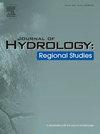Identifying differences in evapotranspiration and ecosystem water use efficiency between different types of urban green spaces: A case study of the main urban area of Beijing
IF 4.7
2区 地球科学
Q1 WATER RESOURCES
引用次数: 0
Abstract
Study region
The main urban area of Beijing, China.
Study focus
Refined modeling is crucial for estimating carbon sequestration and water consumption in urban green spaces. This study used Sentinel-2 data, PT-JPLim, and analytical WUE models to estimate monthly ET and WUE in the main urban area of Beijing (2016–2021) at a 10 × 10 m resolution. Machine learning quantified the effects of environmental factors on ET and WUE across various green space types. Simulations assessed the impacts of different vegetation scenarios on ET and WUE, while urban ET and WUE were predicted for 2022–2100 under different climate scenarios using CMIP6.
New hydrological insights for the region
This study shows that vegetation, especially LAI, is the primary driver of spatiotemporal variations in ET and WUE across urban green spaces in Beijing, contributing 64.7 % and 62.5 % to these changes, respectively. Simulations of a 25 % vegetation increase revealed that residential green spaces are most sensitive, with ET and WUE rising by 6.2 % and 30 %, respectively. The study also estimated water requirements, with net irrigation needs of 95.18 million m³ in normal years and 125 million m³ in dry years. Projections under the SSP126 scenario indicate a near-equilibrium state for carbon sequestration and CO2 concentrations, achieving greater carbon sinks and water conservation with minimal increases in water consumption. These insights are valuable for optimizing water resource management and ecological planning in urban green spaces.
研究区域中国北京主城区。研究重点精细建模对于估算城市绿地的固碳和耗水量至关重要。本研究利用哨兵-2数据、PT-JPLim和WUE分析模型,以10 × 10米的分辨率估算了北京主城区(2016-2021年)的月蒸散发和WUE。机器学习量化了不同绿地类型的环境因素对蒸散发和水分利用效率的影响。模拟评估了不同植被情景对蒸散发和水分利用效率的影响,同时利用 CMIP6 预测了 2022-2100 年不同气候情景下的城市蒸散发和水分利用效率。对植被增加 25% 的模拟显示,居住区绿地最为敏感,蒸散发和水分利用效率分别增加了 6.2% 和 30%。研究还估算了需水量,正常年份的净灌溉需求为 9518 万立方米,干旱年份为 1.25 亿立方米。在 SSP126 情景下进行的预测表明,碳固存和二氧化碳浓度接近平衡状态,实现了更大的碳汇和节水,而耗水量增加极少。这些见解对于优化城市绿地的水资源管理和生态规划很有价值。
本文章由计算机程序翻译,如有差异,请以英文原文为准。
求助全文
约1分钟内获得全文
求助全文
来源期刊

Journal of Hydrology-Regional Studies
Earth and Planetary Sciences-Earth and Planetary Sciences (miscellaneous)
CiteScore
6.70
自引率
8.50%
发文量
284
审稿时长
60 days
期刊介绍:
Journal of Hydrology: Regional Studies publishes original research papers enhancing the science of hydrology and aiming at region-specific problems, past and future conditions, analysis, review and solutions. The journal particularly welcomes research papers that deliver new insights into region-specific hydrological processes and responses to changing conditions, as well as contributions that incorporate interdisciplinarity and translational science.
 求助内容:
求助内容: 应助结果提醒方式:
应助结果提醒方式:


